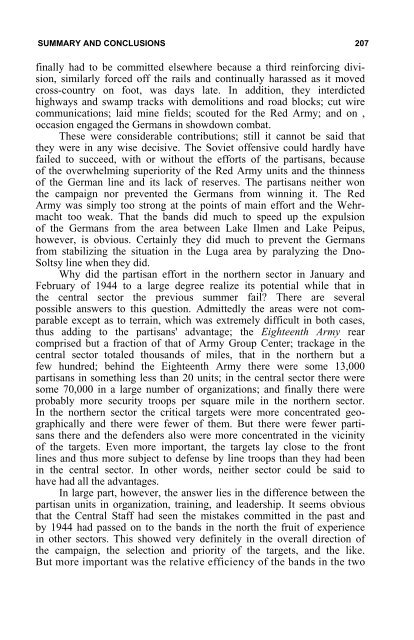the soviet partisan movement 1941-1944 by edgar m. howell
the soviet partisan movement 1941-1944 by edgar m. howell
the soviet partisan movement 1941-1944 by edgar m. howell
You also want an ePaper? Increase the reach of your titles
YUMPU automatically turns print PDFs into web optimized ePapers that Google loves.
SUMMARY AND CONCLUSIONS 207<br />
finally had to be committed elsewhere because a third reinforcing division,<br />
similarly forced off <strong>the</strong> rails and continually harassed as it moved<br />
cross-country on foot, was days late. In addition, <strong>the</strong>y interdicted<br />
highways and swamp tracks with demolitions and road blocks; cut wire<br />
communications; laid mine fields; scouted for <strong>the</strong> Red Army; and on ,<br />
occasion engaged <strong>the</strong> Germans in showdown combat.<br />
These were considerable contributions; still it cannot be said that<br />
<strong>the</strong>y were in any wise decisive. The Soviet offensive could hardly have<br />
failed to succeed, with or without <strong>the</strong> efforts of <strong>the</strong> <strong>partisan</strong>s, because<br />
of <strong>the</strong> overwhelming superiority of <strong>the</strong> Red Army units and <strong>the</strong> thinness<br />
of <strong>the</strong> German line and its lack of reserves. The <strong>partisan</strong>s nei<strong>the</strong>r won<br />
<strong>the</strong> campaign nor prevented <strong>the</strong> Germans from winning it. The Red<br />
Army was simply too strong at <strong>the</strong> points of main effort and <strong>the</strong> Wehrmacht<br />
too weak. That <strong>the</strong> bands did much to speed up <strong>the</strong> expulsion<br />
of <strong>the</strong> Germans from <strong>the</strong> area between Lake Ilmen and Lake Peipus,<br />
however, is obvious. Certainly <strong>the</strong>y did much to prevent <strong>the</strong> Germans<br />
from stabilizing <strong>the</strong> situation in <strong>the</strong> Luga area <strong>by</strong> paralyzing <strong>the</strong> Dno-<br />
Soltsy line when <strong>the</strong>y did.<br />
Why did <strong>the</strong> <strong>partisan</strong> effort in <strong>the</strong> nor<strong>the</strong>rn sector in January and<br />
February of <strong>1944</strong> to a large degree realize its potential while that in<br />
<strong>the</strong> central sector <strong>the</strong> previous summer fail? There are several<br />
possible answers to this question. Admittedly <strong>the</strong> areas were not comparable<br />
except as to terrain, which was extremely difficult in both cases,<br />
thus adding to <strong>the</strong> <strong>partisan</strong>s' advantage; <strong>the</strong> Eighteenth Army rear<br />
comprised but a fraction of that of Army Group Center; trackage in <strong>the</strong><br />
central sector totaled thousands of miles, that in <strong>the</strong> nor<strong>the</strong>rn but a<br />
few hundred; behind <strong>the</strong> Eighteenth Army <strong>the</strong>re were some 13,000<br />
<strong>partisan</strong>s in something less than 20 units; in <strong>the</strong> central sector <strong>the</strong>re were<br />
some 70,000 in a large number of organizations; and finally <strong>the</strong>re were<br />
probably more security troops per square mile in <strong>the</strong> nor<strong>the</strong>rn sector.<br />
In <strong>the</strong> nor<strong>the</strong>rn sector <strong>the</strong> critical targets were more concentrated geographically<br />
and <strong>the</strong>re were fewer of <strong>the</strong>m. But <strong>the</strong>re were fewer <strong>partisan</strong>s<br />
<strong>the</strong>re and <strong>the</strong> defenders also were more concentrated in <strong>the</strong> vicinity<br />
of <strong>the</strong> targets. Even more important, <strong>the</strong> targets lay close to <strong>the</strong> front<br />
lines and thus more subject to defense <strong>by</strong> line troops than <strong>the</strong>y had been<br />
in <strong>the</strong> central sector. In o<strong>the</strong>r words, nei<strong>the</strong>r sector could be said to<br />
have had all <strong>the</strong> advantages.<br />
In large part, however, <strong>the</strong> answer lies in <strong>the</strong> difference between <strong>the</strong><br />
<strong>partisan</strong> units in organization, training, and leadership. It seems obvious<br />
that <strong>the</strong> Central Staff had seen <strong>the</strong> mistakes committed in <strong>the</strong> past and<br />
<strong>by</strong> <strong>1944</strong> had passed on to <strong>the</strong> bands in <strong>the</strong> north <strong>the</strong> fruit of experience<br />
in o<strong>the</strong>r sectors. This showed very definitely in <strong>the</strong> overall direction of<br />
<strong>the</strong> campaign, <strong>the</strong> selection and priority of <strong>the</strong> targets, and <strong>the</strong> like.<br />
But more important was <strong>the</strong> relative efficiency of <strong>the</strong> bands in <strong>the</strong> two
















